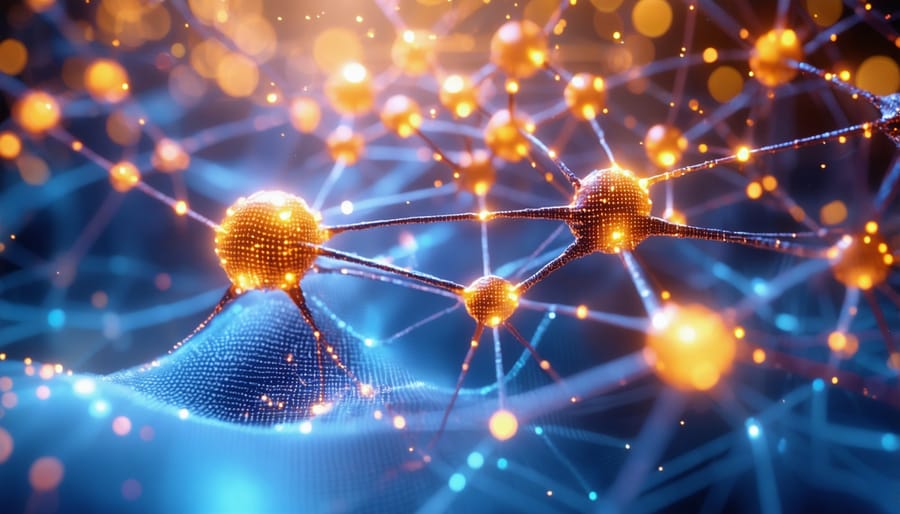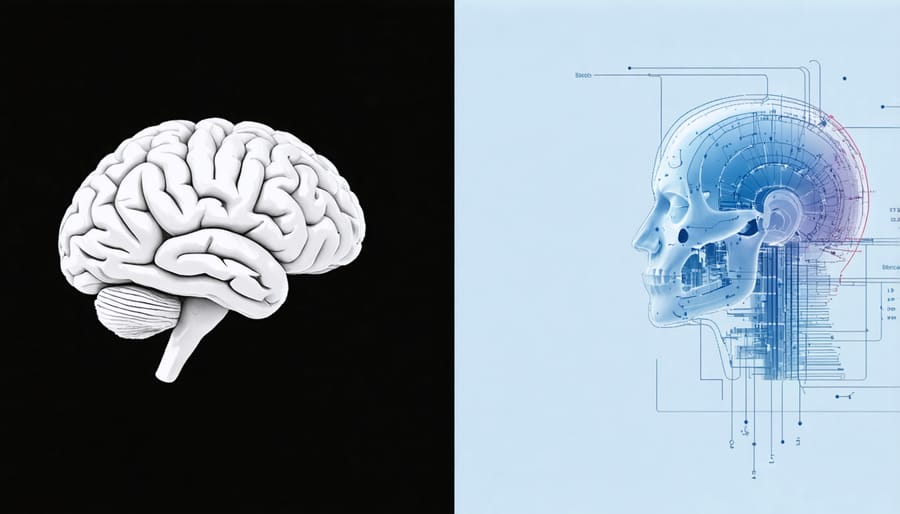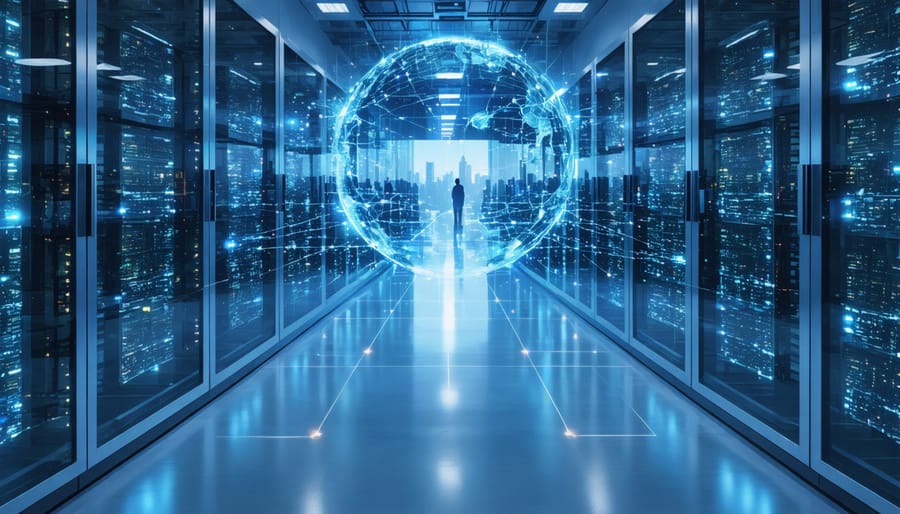In the quiet hum of data centers and the rhythmic whir of automated assembly lines, a revolution is unfolding. Artificial Intelligence, once confined to science fiction, now permeates our daily lives in ways both visible and invisible. From the smartphones that anticipate our next words to the algorithms that guide autonomous vehicles, machines are not merely rising – they’re transforming the very fabric of human civilization.
The last decade has witnessed an unprecedented acceleration in machine learning capabilities, fueled by exponential growth in computing power and breakthrough algorithms. What began as simple pattern recognition has evolved into systems that can diagnose diseases, compose music, and even engage in creative storytelling. This isn’t just technological evolution; it’s a fundamental shift in how humanity interacts with its own creations.
Yet this transformation extends far beyond Silicon Valley laboratories. In factories, hospitals, and homes worldwide, intelligent machines are becoming essential collaborators rather than mere tools. They’re reshaping industries, creating new possibilities, and challenging our traditional understanding of work, creativity, and human potential. As we stand at this technological crossroads, the question isn’t whether machines will rise, but how their ascent will redefine the human experience in the decades to come.
From Simple Programs to Thinking Machines
The Birth of Neural Networks
The journey from simple computational models to today’s sophisticated neural networks marks one of the most fascinating chapters in technological evolution. Building upon early AI breakthroughs, researchers discovered that mimicking the human brain’s structure could revolutionize machine learning.
Neural networks emerged in the 1940s with the pioneering work of Warren McCulloch and Walter Pitts, who created the first mathematical model of a neural network. However, it wasn’t until the 1980s that the concept truly gained momentum. The introduction of the backpropagation algorithm became a game-changer, allowing networks to learn from their mistakes and improve their accuracy over time.
Think of neural networks as digital brains, with layers of interconnected nodes passing information back and forth. Each connection strengthens or weakens based on experience, much like how our brains form and reinforce neural pathways. This architecture enables machines to recognize patterns, make decisions, and even generate creative outputs in ways that were previously impossible with traditional programming.
The rise of deep learning in the 2010s, powered by increased computing power and massive datasets, transformed these networks from theoretical concepts into practical tools that now drive everything from smartphone assistants to autonomous vehicles.

Deep Learning Revolution
The true breakthrough in machine intelligence came with the advent of deep learning, revolutionizing how machines process and understand information. Unlike traditional programming, where humans had to explicitly define every rule, deep learning allows machines to learn patterns from data autonomously. This shift in approach, coupled with advances in neural network development, has enabled computers to achieve remarkable feats in image recognition, natural language processing, and complex decision-making.
The key to deep learning’s success lies in its ability to mimic the human brain’s neural networks, processing information through multiple layers that each extract increasingly complex features from the input data. This hierarchical learning approach has led to breakthrough applications like self-driving cars that can identify road hazards, virtual assistants that understand context and nuance in conversations, and medical AI systems that can detect diseases from medical images with impressive accuracy.
What makes deep learning particularly revolutionary is its scalability and adaptability. As more data becomes available and computing power increases, these systems continue to improve their performance, often surpassing human capabilities in specific tasks while requiring minimal human intervention.
How Modern AI Machines Actually Learn
Pattern Recognition Magic
At the heart of the machine learning evolution lies a remarkable ability that machines have developed: pattern recognition. Much like how humans learn to recognize faces or distinguish between different objects, machines can now identify complex patterns within vast amounts of data.
Imagine teaching a child to identify cats. They learn by seeing multiple examples, noting characteristics like whiskers, pointed ears, and fur. Machines work similarly but with mathematical precision. They analyze thousands of data points, identifying correlations and recurring features that might be invisible to the human eye.
This pattern recognition operates through sophisticated algorithms that break down information into digestible chunks. When processing images, for instance, machines divide them into pixels, analyzing color patterns, shapes, and spatial relationships. In text analysis, they identify word frequencies, sentence structures, and contextual relationships.
What makes this capability truly magical is its scalability and accuracy. While humans might struggle to maintain concentration while analyzing thousands of medical scans, machines can process them tirelessly, spotting subtle patterns that could indicate early signs of disease. In financial markets, they can detect fraud patterns by analyzing millions of transactions in seconds.
The real breakthrough comes from machines’ ability to not just recognize patterns but to learn from them, continuously improving their accuracy and adapting to new variations in data.
Training the Digital Brain
Just as human brains learn through experience, AI systems develop their capabilities through a process called machine learning. This fascinating journey begins with vast amounts of data – the digital equivalent of our sensory experiences. AI systems analyze patterns within this data, gradually building connections and understanding, much like a child learning to recognize objects or speak.
The training process involves three key components: data input, pattern recognition, and feedback loops. Initially, the system receives carefully curated datasets relevant to its intended purpose. For instance, an image recognition AI might start with millions of labeled pictures, while a language model learns from billions of text examples.
These systems learn through different approaches. Supervised learning involves direct guidance, where the AI receives correct answers during training. Unsupervised learning lets the system discover patterns independently, while reinforcement learning rewards correct responses and penalizes mistakes – similar to training a pet.
The feedback loop is crucial: when the AI makes a prediction or decision, it receives information about its accuracy. This feedback helps the system adjust its internal parameters, gradually improving its performance. Modern AI systems can even learn from their own experiences, a process known as deep learning.
What makes this process remarkable is its scalability. While human learning is limited by time and cognitive capacity, AI systems can process enormous amounts of information simultaneously, leading to rapid improvements in capabilities.

Real-World Impact Today

Healthcare Breakthroughs
In healthcare, AI is revolutionizing how doctors diagnose and treat patients, marking one of the most significant transformations in medical history. Machine learning algorithms can now analyze medical images with remarkable accuracy, detecting early signs of diseases like cancer and heart conditions that might escape the human eye.
For instance, AI-powered diagnostic tools can scan thousands of X-rays, MRIs, and CT scans in minutes, highlighting potential abnormalities and helping radiologists work more efficiently. These systems learn from millions of previous cases, continuously improving their accuracy and reliability.
AI is also personalizing treatment plans by analyzing vast amounts of patient data. By considering factors like genetic makeup, lifestyle, and medical history, these systems can predict which treatments are most likely to succeed for individual patients. This approach has already shown promising results in cancer treatment, where AI helps oncologists select the most effective combination of drugs.
In emergency care, machine learning models are helping predict patient deterioration before obvious symptoms appear, allowing medical staff to intervene earlier and potentially save lives. These advances aren’t replacing healthcare professionals but rather enhancing their capabilities and helping them make more informed decisions.
Smart Cities and Infrastructure
Smart cities are becoming a reality as AI transforms urban landscapes into intelligent, interconnected environments. Machine learning algorithms now manage traffic flow in real-time, adjusting signal timing to reduce congestion and improve emergency response times. Cities like Singapore and Barcelona have implemented AI-powered systems that analyze data from thousands of sensors to optimize everything from waste collection to energy consumption.
These intelligent systems are revolutionizing public transportation by predicting maintenance needs before breakdowns occur and adjusting service frequency based on demand patterns. In parking management, AI helps drivers find available spots quickly, reducing both emissions and frustration. Smart lighting systems automatically adjust brightness based on foot traffic and weather conditions, saving energy while maintaining safety.
Perhaps most impressively, AI is enabling predictive infrastructure maintenance. Sensors embedded in bridges, roads, and buildings constantly monitor structural health, alerting authorities to potential issues before they become dangerous. This proactive approach not only saves money but also prevents disasters and extends the lifespan of critical infrastructure. As cities continue to grow, these AI-driven solutions are becoming essential tools for creating more efficient, sustainable, and livable urban environments.
Personal AI Assistants
Personal AI assistants have revolutionized how we interact with technology in our daily lives. From Siri and Alexa to Google Assistant, these AI-powered companions have become integral parts of millions of households worldwide. They’ve evolved from simple voice-command systems to sophisticated helpers that can manage our schedules, control smart home devices, and even anticipate our needs.
These digital assistants leverage natural language processing and machine learning to understand and respond to human speech with increasing accuracy. They learn from each interaction, becoming more personalized and efficient over time. For instance, they can recognize individual voice patterns, adapt to speech accents, and remember personal preferences for music, news, and entertainment.
The impact extends beyond basic task automation. Modern AI assistants can help monitor health metrics, suggest workout routines, and even detect emergency situations. They serve as educational tools for children, offering interactive learning experiences and answering curious questions. In professional settings, they boost productivity by managing emails, scheduling meetings, and providing real-time information.
However, this convenience comes with considerations about privacy and data security. As these assistants collect and process personal information to provide personalized experiences, users must understand and manage their privacy settings. Despite these concerns, the trajectory of personal AI assistants points toward even deeper integration into our daily routines, with upcoming advances in emotional intelligence and contextual understanding promising even more natural and helpful interactions.
The Road Ahead
Emerging Capabilities
The landscape of artificial intelligence is rapidly expanding, with breakthrough capabilities emerging at an unprecedented pace. Generative AI technology has revolutionized how machines create content, from writing human-like text to producing stunning artwork and composing music.
Recent developments in machine learning have enabled AI systems to engage in more nuanced conversations, understand context better, and even display basic forms of reasoning. Natural language processing has evolved to the point where AI can now understand and respond to complex queries across multiple languages, making real-time translation and interpretation more accurate than ever before.
Computer vision systems have achieved remarkable accuracy in object recognition and scene understanding, leading to applications in autonomous vehicles, medical diagnosis, and security systems. These systems can now detect subtle patterns that might escape human observation, potentially revolutionizing fields like cancer detection and quality control in manufacturing.
Perhaps most intriguingly, AI is beginning to show promise in areas previously thought to be exclusively human domains. Systems are learning to recognize and respond to emotional cues, collaborate in team settings, and even engage in creative problem-solving. Researchers are also making strides in developing AI that can explain its decision-making process, addressing one of the field’s most significant challenges: transparency and interpretability.
These emerging capabilities suggest we’re entering a new era where machines become increasingly sophisticated partners in both professional and personal contexts, though significant ethical and practical challenges remain to be addressed.
Ethical Considerations
As AI systems become increasingly sophisticated, the ethical implications of their development and deployment demand our careful attention. One of the primary concerns is the impact on employment, as automation continues to transform various industries. While new jobs are created, others may become obsolete, necessitating a thoughtful approach to workforce transition and retraining programs.
Privacy and data protection represent another crucial ethical consideration. As machines collect and process vast amounts of personal information, we must establish robust frameworks to protect individual privacy rights while maintaining the benefits of technological advancement. This includes implementing transparent data collection practices and giving users greater control over their information.
The question of accountability in AI decision-making also raises important ethical questions. When autonomous systems make decisions that affect human lives – from medical diagnoses to financial lending – who bears responsibility for these choices? This challenge requires developing clear guidelines for AI accountability and ensuring human oversight in critical applications.
Bias in AI systems remains a significant concern, as these systems can inadvertently perpetuate existing social inequalities. Developers must actively work to identify and eliminate biases in training data and algorithms, ensuring fair and equitable treatment for all users. Additionally, maintaining human agency and preventing over-reliance on automated systems is essential for preserving human autonomy and decision-making capabilities.
As we reflect on the remarkable journey of machine learning and neural networks, it’s clear that we’re witnessing a technological revolution that continues to reshape our world. From humble beginnings in pattern recognition to today’s sophisticated AI systems that can diagnose diseases, drive cars, and engage in natural conversations, machines have evolved far beyond their original programming.
The impact of this transformation extends across every sector of society. Healthcare professionals now work alongside AI to detect diseases earlier and develop personalized treatments. Manufacturing facilities operate with unprecedented efficiency through smart automation. Even creative industries are experiencing a renaissance as AI tools augment human creativity in art, music, and design.
Looking ahead, the potential seems boundless. Quantum computing promises to supercharge AI capabilities, while advances in deep learning could bring us closer to artificial general intelligence. However, this progress also brings important considerations about ethics, job displacement, and the need for responsible AI development.
The key to navigating this future lies in maintaining a balance between technological advancement and human values. As machines become more capable, our focus must shift to developing AI systems that complement human abilities rather than replace them. Education and reskilling initiatives will be crucial in preparing society for this evolving landscape.
The rise of machines isn’t just about technology – it’s about how we choose to shape our future with these powerful tools at our disposal.

